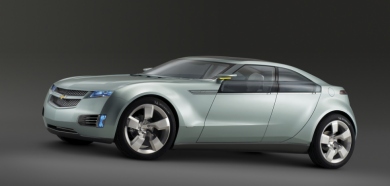|
The Volt conveys an immediate
message of agility and sophistication, with exterior proportions
more commonly associated with classic sports cars. Twenty-one-inch
wheels and sheer, taut surface relationships reiterate the
statement. The Chevrolet Volt’s athletic design challenges the
notion that an environmentally conscious vehicle can’t be beautiful
and possess an aesthetic spirit that matches its driving
characteristics.
Inside, a host of current or near-term
technologies and materials, combined with ingenious use of ambient
light, creates an interior environment that’s light, airy and thoughtful.
|
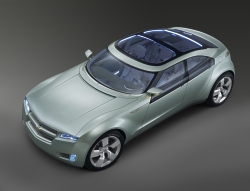
Click to enlarge
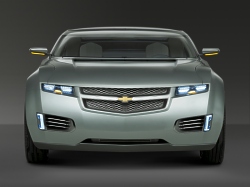
Click to enlarge
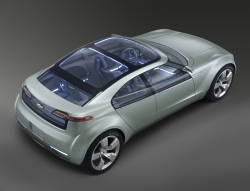
Click to enlarge
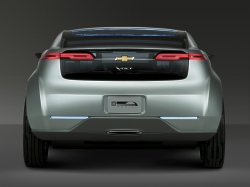
Click to enlarge |
Sized for an urban-centric lifestyle,
the Volt concept sedan carries dimensions similar to a Chevrolet Cobalt,
with an overall length of approximately 170 inches (4,318 mm), a height
of 52.6 inches (1,336 mm) and a width of 70.5 inches (1,791 mm).
However, the Volt’s proportions, dictated by the layout of its
electrically driven powertrain system, make it distinctly different from
its mainstream Cobalt sibling.
“The configuration of the drive and energy
components dictated we push the front wheels forward and outward to the
corners,” said Bob Boniface, design director, GM Design, and lead
exterior designer. “We wanted to keep the overall dimensions relatively
small. This is an urban-centric car, so it needs to fit into small
areas.”
The Volt’s proportions, combined with
large wheels, wide front and rear tracks (64 inches / 163 mm, front and
rear) and a tight wheel-to-body relationship, enable a sporty, confident
stance. Other key proportional highlights include a dash-to-axle length
that positions the driver far rearward of the front wheels; large
21-inch by 7.5-inch wheels; short front and rear overhangs and departure
angles that deliver a sense of taut, compact energy. Also, the offsets
between the upper glass elements and tire planes (the glass is inboard
of the face of the tires) contribute to the sedan’s balanced stance and
enhance the vehicle’s dynamic static image, resulting in pure, athletic
proportions.
The front door hinges enable
enhanced entry/egress to the vehicle, as well as a graceful,
forward-leaning door cut line. Milled from billets of stainless steel,
the hinges serve as design elements, extending into the front quarter
fenders and incorporating a plug-in recharging port access on both sides
of the vehicle.
The vehicle face – designed to
carry a serious, confident appearance – is clearly Chevrolet, with a
twin-port front grille, center-positioned bowtie and lower air intake.
Horizontal headlamps with aluminum bezels deliver a jeweled appearance,
leading to translucent light-emitting diode (LED) forward illumination
elements. |
The Volt’s roof, side glass and
beltline are constructed of GE Plastics transparent, glazed polycarbonate
material that delivers the scratch resistance and gloss surface appearance
of glass, combined with the formability of a plastic composite.
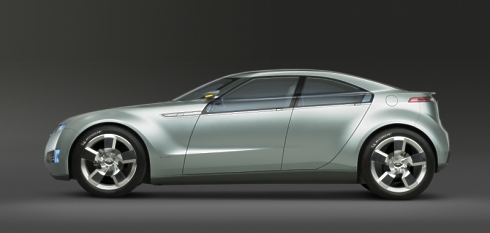
Click to enlarge
In addition to the upper daylight opening
and roof, key exterior panels are made with a GE Plastics composite, and
each – in and of itself – is designed as an artful shape that could be
displayed on its own. As a result, the exterior panels fit together like a
well-crafted puzzle, with flowing surface-to-surface cut lines that bring a
sophisticated composition and overall harmony to the Volt’s exterior
appearance.
The underside of the vehicle consists
of a flat, composite molded belly pan that is integrated with the fascias
and rockers for a clean, uncluttered and finished appearance. The belly pan
– which contributes significantly to the Volt’s 0.30 coefficient of drag –
contributes to the sedan’s overall impression of refinement and demonstrates
the design of the underbody was just as important as the upper body.
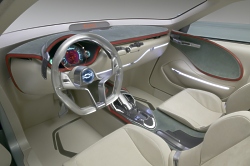
Click to enlarge
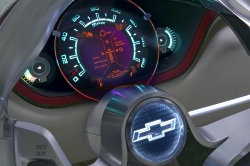
Click to enlarge
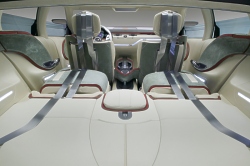
Click to enlarge

Click to enlarge

Click to enlarge

Click to enlarge
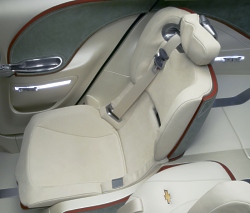
Click to enlarge |
The interior environment of the
Volt was designed to appeal to an urban dweller who desires a smart,
daily-use vehicle, according to Wade Bryant, design director, GM
Design.
“On the interior of the Volt, you’ll
find technologies, materials and an environment that enable the car
to help make life simpler for a person who’s environmentally
conscious and leads a city-centered lifestyle,” said Bryant. “It’s
ergonomically correct, provides connectivity to the world, and
demonstrates smart responsibility through the use of lightweight,
recyclable materials.” Two such examples are the instrument panel
topper and steering wheel made with GE Plastics.
Bryant said the interior environment
of the four-passenger Volt is defined by a host of current or
near-term technologies and materials combined with the ingenious use
of ambient light. “It’s definitely based in reality. All the things
you see on the interior are within reach in the next few years.”
Super Imaging is an innovative,
dual-mode technology display that provides two visual levels of
vehicle information to the driver in the instrument cluster. It is a
design innovation developed to provide a primary interface between
the driver and the vehicle’s key feature: the next-generation,
electrically driven propulsion system.
“The dual-mode instrument cluster was
developed to highlight the car’s plug-in capability,” said Bryant.
“The powertrain technology is the key feature, so we wanted to make
sure the interior communicated that, and the driver would have a
sophisticated, fun and useful interaction with the electric-drive
system.”
The first level of information
– configured similarly to a conventional instrument cluster –
provides traditional data in the form of analog, three-dimensional
(3D) LED displays, including three gauges for fuel level,
speedometer, odometer, battery level and the transmission “PRNDL”
indicator. The second level of information – a transparent screen
positioned in front of the 3D LED displays – delivers color,
animated data related to the Volt’s advanced propulsion system with
a holographic-like appearance.
Super Imaging works by using
invisible, fluorescent inks that are printed on the transparent
screen. When illuminated by an ultraviolet (UV) laser projector
located behind the instrument cluster (from the driver’s
perspective), the inks become excited, and provide four-color
illumination and animation.
Compression-molded foam with a
textile-patterned surface layer is applied on the entire lower
instrument panel, lower door trim panels and rear quarter trim
areas. The material enables soft, tactile, low-gloss surfaces
throughout the interior cabin that appear hand-crafted and
specifically tailored to the car.
This material, used in some of the
latest luggage designs, enables zippered access to traditional
storage areas such as the glove box, doors, etc. The material is
very inexpensive, wears well and enables flexibility in design.
Molded GE plastic panels
provide thin, structural interior surfaces that can be cantilevered
in space. The material is applied on the upper instrument panel,
seat backs, center console sides and door inserts. |
The aspect of light – from outside and
within the vehicle – is played throughout the interior environment.
Highlights include a transparent upper roof that provides large quantities
of natural light and is enhanced with thinner pillars and rail sections;
Gelcore® LED indirect lighting around the roof periphery that illuminates
during evening hour entry/egress and can be seen from outside the vehicle;
LED functional storage lighting that passes through transparent zippers and
provides ambient light during evening hours; and conductive ink controls
situated on the interior surface of the glass roof that provide touch access
to lights, OnStar buttons and more.
January 08, 2007
top
|
www.autointell.com
- The Web for Automotive Professionals
|
|




